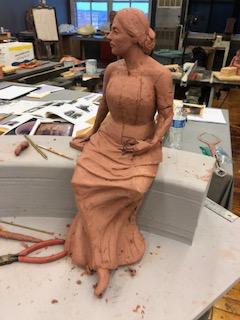Historic pipe sparks debate
Editor’s Note: The Dec. 27 print version of Sippican Week inaccurately stated that the committee had decided to eliminate a pipe from the Elizabeth Taber statue. The following revised version of the article corrects the inaccuracy.
MARION — Elizabeth Taber may — or may not — be smoking in front of the Marion Town House.
The Board of Health objected to the plans for the statue because they depicted the Marion philanthropist with a pipe. The Board asserted in a letter that this might encourage children to smoke.
Chair of the committee, Judith Rosbe clarified that the group intended the pipe to demonstrate Taber’s eccentricity, but never intended to promote unhealthy habits.
“She wasn’t going to be smoking it, she was just going to be cupping it in her hand,” Rosbe said, adding that, “it’s not anything that we [the committee] feel strongly about. We’ve taken an informal survey of our members, and most of them say ‘let’s not alienate anybody.’”
The committee’s next meeting is Jan. 15, so it is still undetermined what the pipe will change to.
“Somebody suggested holding five keys for [Taber’s] five remaining buildings, but we really haven’t decided for sure,” Rosbe said.
Though the committee may leave out that eccentricity, they are otherwise committed to historical accuracy.
“We want to be as historically accurate as possible, and our sculptor, Erik Durant, did a lot of research on her,” Rosbe said. “He has been going to the whaling museum to see the kind of dresses they wore back then”
Taber certainly has a long history with Marion. She was born Elizabeth Sprague Pitcher, and spent the first thirty three years of her life in Marion village growing up, teaching children to read and write, and to be responsible citizens.
In 1824 she married Stephen Taber, a clock maker in Acushnet, and they moved to New Bedford where they invested their money in whaling ships, mill stocks, and railroad bonds. Rosbe said that the group knows about this last investment because they received a call this summer about old railroad stock certificate in her name.
Taber’s three children all died in infancy, and Stephen passed away in 1862. Taber subsequently returned to Marion to enrich the lives of its citizens.
Taber’s generosity to Marion included six buildings, parks, trees, cemeteries, and endowment monies for the maintenance of her new creations. Many of her projects revolved around education, the church, or socialization and cultural enrichment for citizens.
Taber established the Elizabeth Taber Library as her first project in 1872. Included with the gift was a $15,000 endowment, a $4,000 life insurance policy, and a gift of her own furniture. In addition, she also gave a $6,000 legacy for the proposed Natural History Museum above the library.
Taber also focused in on education for schoolchildren with the Tabor Academy Academic Building, which she had built in 1876. In the thirties, the town of Marion made a building trade with Tabor Academy and this building became the Marion Town Hall.
As a related project, Taber funded the construction of a house for the principal of Tabor Academy, Mr. Clark Howland, in 1880. She also benefited from the building, as she resided in an apartment on the second floor until her death in 1888 at the age of 97.
“The smoking doesn’t seem to have affected her too much, if she lived to 97,” Rosbe noted. She also pointed out that there are many other cultural references that involve smoking.
“Someone came up to me and said, ‘goodness gracious, what’s next, Frosty the Snowman and his corncob pipe?’” she added.
The Tabor House building was originally located where Sippican School is today, and was later moved to its present location on Cottage Street.=
Taber also funded the construction of a building for religious education, the Marion Congregational Church chapel in 1885. Taber wanted to construct the building because she did not think it proper for children to have Sunday school in the basement of the church.
Between education-related buildings, Taber also constructed spaces for the artistic and cultural lives of Marion citizens. In 1876, she was the patron for Union Hall, her third building. It was for the ladies of the Congregational Church to hold their sewing groups and social occasions. Union Hall was located on South Street where the Fellowship Hall of St. Gabriel’s now stands.
Taber’s final gift to Marion was the Music Hall which fulfilled her desire to “put some snap into Marion,” and provide a hall for musical and theatrical performances to enhance the cultural life in her beloved town. Unfortunately, Taber never got to see it, as she died before it was completed.














